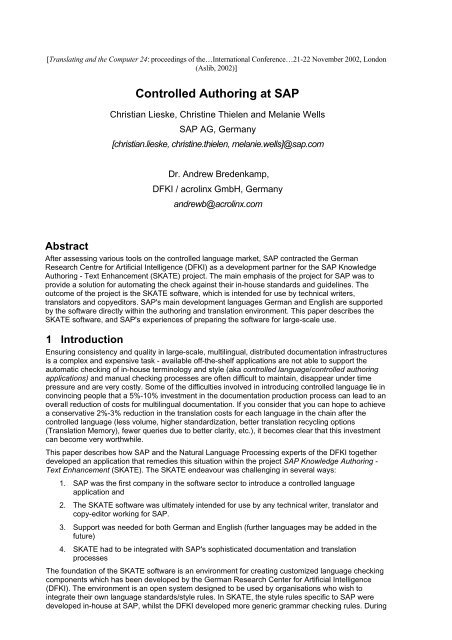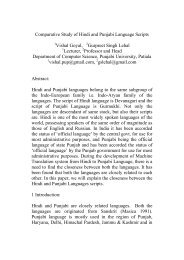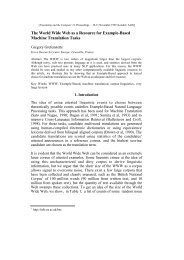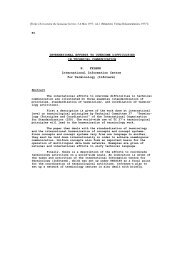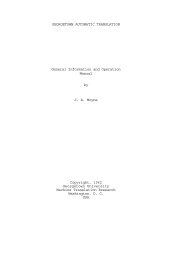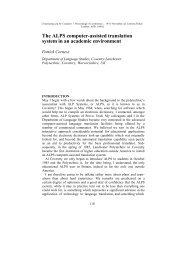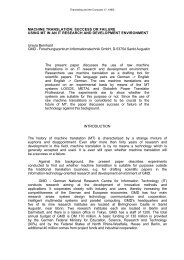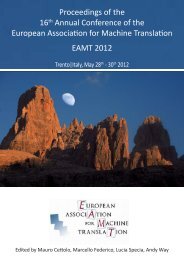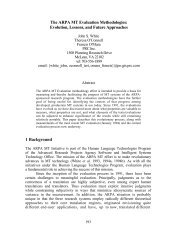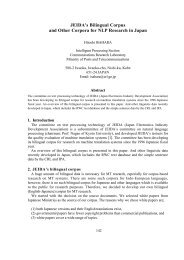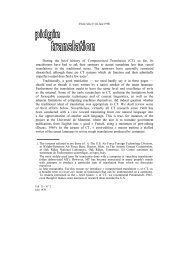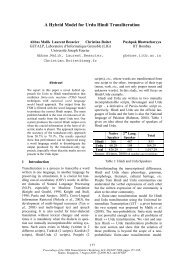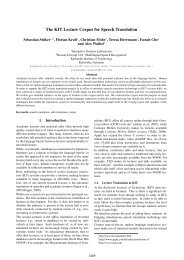Controlled authoring at SAP - Machine Translation Archive
Controlled authoring at SAP - Machine Translation Archive
Controlled authoring at SAP - Machine Translation Archive
You also want an ePaper? Increase the reach of your titles
YUMPU automatically turns print PDFs into web optimized ePapers that Google loves.
[Transl<strong>at</strong>ing and the Computer 24: proceedings of the…Intern<strong>at</strong>ional Conference…21-22 November 2002, London<br />
(Aslib, 2002)]<br />
<strong>Controlled</strong> Authoring <strong>at</strong> <strong>SAP</strong><br />
Christian Lieske, Christine Thielen and Melanie Wells<br />
<strong>SAP</strong> AG, Germany<br />
[christian.lieske, christine.thielen, melanie.wells]@sap.com<br />
Dr. Andrew Bredenkamp,<br />
DFKI / acrolinx GmbH, Germany<br />
andrewb@acrolinx.com<br />
Abstract<br />
After assessing various tools on the controlled language market, <strong>SAP</strong> contracted the German<br />
Research Centre for Artificial Intelligence (DFKI) as a development partner for the <strong>SAP</strong> Knowledge<br />
Authoring - Text Enhancement (SKATE) project. The main emphasis of the project for <strong>SAP</strong> was to<br />
provide a solution for autom<strong>at</strong>ing the check against their in-house standards and guidelines. The<br />
outcome of the project is the SKATE software, which is intended for use by technical writers,<br />
transl<strong>at</strong>ors and copyeditors. <strong>SAP</strong>'s main development languages German and English are supported<br />
by the software directly within the <strong>authoring</strong> and transl<strong>at</strong>ion environment. This paper describes the<br />
SKATE software, and <strong>SAP</strong>'s experiences of preparing the software for large-scale use.<br />
1 Introduction<br />
Ensuring consistency and quality in large-scale, multilingual, distributed document<strong>at</strong>ion infrastructures<br />
is a complex and expensive task - available off-the-shelf applic<strong>at</strong>ions are not able to support the<br />
autom<strong>at</strong>ic checking of in-house terminology and style (aka controlled language/controlled <strong>authoring</strong><br />
applic<strong>at</strong>ions) and manual checking processes are often difficult to maintain, disappear under time<br />
pressure and are very costly. Some of the difficulties involved in introducing controlled language lie in<br />
convincing people th<strong>at</strong> a 5%-10% investment in the document<strong>at</strong>ion production process can lead to an<br />
overall reduction of costs for multilingual document<strong>at</strong>ion. If you consider th<strong>at</strong> you can hope to achieve<br />
a conserv<strong>at</strong>ive 2%-3% reduction in the transl<strong>at</strong>ion costs for each language in the chain after the<br />
controlled language (less volume, higher standardiz<strong>at</strong>ion, better transl<strong>at</strong>ion recycling options<br />
(Transl<strong>at</strong>ion Memory), fewer queries due to better clarity, etc.), it becomes clear th<strong>at</strong> this investment<br />
can become very worthwhile.<br />
This paper describes how <strong>SAP</strong> and the N<strong>at</strong>ural Language Processing experts of the DFKI together<br />
developed an applic<strong>at</strong>ion th<strong>at</strong> remedies this situ<strong>at</strong>ion within the project <strong>SAP</strong> Knowledge Authoring -<br />
Text Enhancement (SKATE). The SKATE endeavour was challenging in several ways:<br />
1. <strong>SAP</strong> was the first company in the software sector to introduce a controlled language<br />
applic<strong>at</strong>ion and<br />
2. The SKATE software was ultim<strong>at</strong>ely intended for use by any technical writer, transl<strong>at</strong>or and<br />
copy-editor working for <strong>SAP</strong>.<br />
3. Support was needed for both German and English (further languages may be added in the<br />
future)<br />
4. SKATE had to be integr<strong>at</strong>ed with <strong>SAP</strong>'s sophistic<strong>at</strong>ed document<strong>at</strong>ion and transl<strong>at</strong>ion<br />
processes<br />
The found<strong>at</strong>ion of the SKATE software is an environment for cre<strong>at</strong>ing customized language checking<br />
components which has been developed by the German Research Center for Artificial Intelligence<br />
(DFKI). The environment is an open system designed to be used by organis<strong>at</strong>ions who wish to<br />
integr<strong>at</strong>e their own language standards/style rules. In SKATE, the style rules specific to <strong>SAP</strong> were<br />
developed in-house <strong>at</strong> <strong>SAP</strong>, whilst the DFKI developed more generic grammar checking rules. During
the project, <strong>SAP</strong> put particular emphasis on usability and user interface issues to ensure acceptance<br />
by users.<br />
<strong>SAP</strong>'s user feedback and structured usability testing helped to improve the system design of the<br />
original DFKI environment, especially for the user interface and user interaction design (see section 3).<br />
2 A <strong>Controlled</strong> Authoring Applic<strong>at</strong>ion for <strong>SAP</strong><br />
<strong>SAP</strong>'s group for MultiLingual Technology conducted a market analysis, and a subsequent evalu<strong>at</strong>ion<br />
of existing controlled <strong>authoring</strong> applic<strong>at</strong>ions in 1999. The outcome was, th<strong>at</strong> off-the-shelf products<br />
available on the market, did not fulfil all of <strong>SAP</strong>'s needs. Accordingly, it was decided to set up the<br />
project <strong>SAP</strong> Knowledge Authoring - Text Enhancement (SKATE) to develop a controlled <strong>authoring</strong><br />
applic<strong>at</strong>ion which would take these needs into consider<strong>at</strong>ion. This chapter sketches highlights of the<br />
project's software development life cycle, and depicts how the resulting applic<strong>at</strong>ion can currently be<br />
used.<br />
2.1 Requirements Analysis<br />
The first development-rel<strong>at</strong>ed activity of the controlled <strong>authoring</strong> project <strong>at</strong> <strong>SAP</strong>, was a detailed<br />
requirements analysis. The main results of this project phase were th<strong>at</strong> the applic<strong>at</strong>ion<br />
1. must be customizable in-house (most importantly to include <strong>SAP</strong>-specific style rules)<br />
2. needs to support software-rel<strong>at</strong>ed texts (accordingly, it has to be able to cope with common<br />
words and wording in this domain)<br />
3. must support German and English (with an option for additional languages)<br />
4. should be very easy to use (since in the end any technical writer, transl<strong>at</strong>or and copy-editor<br />
working for <strong>SAP</strong> may use it)<br />
5. must fit seamlessly with <strong>SAP</strong>'s sophistic<strong>at</strong>ed document<strong>at</strong>ion and transl<strong>at</strong>ion processes (for<br />
example, it should be easy to integr<strong>at</strong>e the applic<strong>at</strong>ion into Microsoft Word®, one of <strong>SAP</strong>'s<br />
most important editors)<br />
6. must enable both interactive use and background b<strong>at</strong>ch-processing (which should summarize<br />
checking results in reports)<br />
7. must be powerful and highly scalable (due to the high number of possible users, and the large<br />
volumes which may have to be checked)<br />
2.2 Design Decisions<br />
Obviously, certain design decisions were required for a controlled <strong>authoring</strong> applic<strong>at</strong>ion to fulfil <strong>SAP</strong>'s<br />
needs. Most notably, the technology to be used for the actual checking of style rule viol<strong>at</strong>ions had to<br />
be selected. This section describes some of the design decisions which were made during the project.<br />
Since the software development lifecycle followed an iter<strong>at</strong>ive model, not all of the decisions were<br />
made <strong>at</strong> the beginning of the project. Certain aspects of the user interface, and user interface design<br />
for example were only made after the rigid usability tests which were conducted l<strong>at</strong>er in the project.<br />
2.2.1 Language Checking Software<br />
The market analysis and evalu<strong>at</strong>ion of existing controlled language tools had already indic<strong>at</strong>ed th<strong>at</strong><br />
only a few applic<strong>at</strong>ions provided a good starting point for an <strong>SAP</strong>-driven development project. After the<br />
discussion of detailed requirements, and licensing options, <strong>SAP</strong> ultim<strong>at</strong>ely decided to partner with the<br />
German Research Center for Artificial Intelligence (DFKI). Their Flexible Language and Grammar<br />
Checker (FLAG) development environment thus became the backbone of the SKATE Language<br />
Checking Software (LCS). The most important modules of the LCS are:<br />
• Part of Speech (POS) Tagger - (Brants, 2000) tags each sentence element with a detailed<br />
gramm<strong>at</strong>ical c<strong>at</strong>egory based on the Penn Treebank tagset. This tagger is st<strong>at</strong>istical, so copes<br />
well with words which are not stored in its lexicon.
• Part of Speech (POS) Lexicon - lists words with possible tags for the POS tagger. Tags for<br />
each word are also weighted according to frequency of occurrence within a particular corpus 1<br />
• Morphological Analyser - (Petitpierre and Russell, 1995) provides a morphological analysis<br />
of words; analysis can be used in checking rules th<strong>at</strong> specify, for example, th<strong>at</strong> certain<br />
elements must be third person singular<br />
• Chunker - (Skut and Brants, 1998) identifies noun phrases (NPs) and verb phrases (VPs);<br />
results can be used by checking rules to check whether certain elements are within an NP<br />
• Rule Engine - m<strong>at</strong>ches results from the N<strong>at</strong>ural Language Processing components (for<br />
example, the chunker) against formalized checking rules<br />
2.2.2 User Interface/User Interaction<br />
<strong>SAP</strong>'s interest in usability (see section 3) led to several modific<strong>at</strong>ions of the user interface which<br />
existed in the original DFKI environment. The modific<strong>at</strong>ions fall into the following areas:<br />
1. more ergonomic user interaction:<br />
make most common actions as simple and easy as possible (single click on a marker to remove it,<br />
double click on a marker to see inform<strong>at</strong>ion rel<strong>at</strong>ed to it (e.g. the name of the rule th<strong>at</strong> has been<br />
viol<strong>at</strong>ed)<br />
2. single inform<strong>at</strong>ion area:<br />
use a Web browser (r<strong>at</strong>her than a combin<strong>at</strong>ion of Web browser and Microsoft Windows®/Word®<br />
dialog boxes) to display inform<strong>at</strong>ion; this also resulted in more independence from Microsoft<br />
Word^ and other options for help resources (see section 2.3.2.4)<br />
3. better configurability:<br />
enable, for example, different levels of inform<strong>at</strong>ion for expert and novice users.<br />
2.2.3 Checking Reports<br />
From the very beginning, <strong>SAP</strong>'s usage scenarios included both interactive use and background b<strong>at</strong>ch-<br />
processing. In each scenario, a need to summarize checking results in special reports was identified.<br />
In order to be as flexible as possible, it was decided to base the reports on XML documents which are<br />
gener<strong>at</strong>ed server-side by the Language Checking Software. These XML documents (which have been<br />
formalized by means of an XSD schema, see figure 1) capture all of the inform<strong>at</strong>ion th<strong>at</strong> might be<br />
interesting for the different agents in the usage scenarios (e.g. authors, checking rule developers,<br />
copy-editors). Inform<strong>at</strong>ion in the XML documents includes the following:<br />
• administr<strong>at</strong>ive inform<strong>at</strong>ion ( element): user profile (e.g. user name, settings, input text) the<br />
checking workflow and the user environment (e.g. version of the used LCS)<br />
• results of a language checking session ( element): for each checking type (style,<br />
grammar, terminology, unknown words) a summary of the found errors and a listing of the<br />
viol<strong>at</strong>ions with an error description and context inform<strong>at</strong>ion ( element)<br />
With this XML-based design it is possible to gener<strong>at</strong>e different views on the checking results and<br />
different output form<strong>at</strong>s (for example HTML and PDF). It is possible to give detailed listings of the<br />
errors with the corresponding context inform<strong>at</strong>ion, e.g. for the evalu<strong>at</strong>ion of checking rules, or to<br />
calcul<strong>at</strong>e st<strong>at</strong>istics for quality assurance purposes. Users can view the reports directly with a single<br />
mouse click, or collect them for further processing.<br />
1 The weightings were modified during the project to adapt them to <strong>SAP</strong>'s technical document<strong>at</strong>ion.
2.3 Implement<strong>at</strong>ion<br />
2.3.1 Language Checking Software<br />
Figure 2: LCS server<br />
For ease of maintenance and scalability, SKATE is based on a Language Checking Software (LCS)<br />
with a client-server architecture. The typical end-user environment (e.g. Microsoft Word® editor)<br />
<strong>at</strong>taches to the LCS client via COM calls. The LCS client and LCS server communic<strong>at</strong>e via HTTP and<br />
TCP/IP.<br />
A typical interaction is as follows:<br />
1. The LCS client sends a text (document segments, whole document or a set of documents) to the<br />
LCS server together with a user profile<br />
2. The LCS server replies to the client with a set of results<br />
3. The user can view the results directly in the edited text and as an XML report th<strong>at</strong> can be<br />
displayed in a browser or evalu<strong>at</strong>ed by further transform<strong>at</strong>ions<br />
The LCS server is a multi-user server implemented in Java with some underlying processing<br />
components implemented as libraries in C/C++. It runs on Microsoft Windows NT/2000®, Solaris or<br />
Linux. For each language (German, and English), <strong>SAP</strong> oper<strong>at</strong>es one server. A meta-server re-routes<br />
requests to the appropri<strong>at</strong>e language server.<br />
Each language-specific LCS server consists of language-specific processing components (e.g. for<br />
tokeniz<strong>at</strong>ion, part-of-speech tagging, morphological analysis), lexical resources and a number of<br />
implemented style and grammar checking rules (different rule sets are defined for different text types)<br />
and help resources for checking results (see figure 2). The processing components, the general lexical<br />
resources and parts of the grammar checking rules have been provided by the DFKI. The cre<strong>at</strong>ion and<br />
administr<strong>at</strong>ion of all other <strong>SAP</strong>-specific resources and checking rules are part of the customizing<br />
process done <strong>at</strong> <strong>SAP</strong>.
2.3.2 Linguistic D<strong>at</strong>a and Help Resources<br />
The LCS processing components make use of large amounts of linguistic d<strong>at</strong>a consisting of<br />
• checking rules for style and grammar checking<br />
• <strong>SAP</strong> terminology and general lexicons for style, grammar and terminology checking<br />
• abbrevi<strong>at</strong>ion lists for text segment<strong>at</strong>ion and tokeniz<strong>at</strong>ion<br />
Checking rules and <strong>SAP</strong> terminology are linked to corresponding help resources so th<strong>at</strong> the author<br />
gets appropri<strong>at</strong>e help during language checking (e.g. style and grammar guidelines, examples, term<br />
definitions).<br />
2.3.2.1 Checking Rules<br />
One of <strong>SAP</strong>'s main requirements for the development of a controlled <strong>authoring</strong> applic<strong>at</strong>ion was the<br />
customiz<strong>at</strong>ion of the LCS for <strong>SAP</strong>-specific writing standards, i.e. the in-house implement<strong>at</strong>ion of style<br />
checking rules. After some training on the error specific<strong>at</strong>ion formalism used by the system<br />
(Bredenkamp et al., 2000) this work was performed by comput<strong>at</strong>ional linguists in the MultiLingual<br />
Technology (MLT) group <strong>at</strong> <strong>SAP</strong>.<br />
Concerning general grammar checking the DFKI provided a set of rules based on standard grammar<br />
liter<strong>at</strong>ure (for German: Duden 9,1997) and a (small) provided text corpora of <strong>SAP</strong> texts. For English<br />
the grammar rules were heavily reworked <strong>at</strong> <strong>SAP</strong> based on inform<strong>at</strong>ion found <strong>at</strong> various internet sites<br />
and some relevant liter<strong>at</strong>ure (e.g. Hargis, 1998) and real-life errors found in the document<strong>at</strong>ion.<br />
Rule Selection<br />
For the first introduction of the controlled <strong>authoring</strong> applic<strong>at</strong>ion, <strong>SAP</strong> decided to only implement a small<br />
number of checking rules, to allow user acceptance to be monitored. The selection of relevant style<br />
rules took some time because <strong>SAP</strong> has a large volume of existing writing standards (e.g. for German:<br />
<strong>SAP</strong> HORIZON L156, 2002) to be considered before any decisions could be made about which were<br />
the most relevant rules to be implemented. A rule is considered relevant, if the viol<strong>at</strong>ion of this rule<br />
• makes a text difficult to read and comprehend<br />
• makes (human or machine) transl<strong>at</strong>ion difficult<br />
• occurs frequently<br />
• damages the corpor<strong>at</strong>e image<br />
• can be implemented<br />
During the whole selection process it was necessary to consult with various <strong>SAP</strong>-internal groups<br />
involved in the process of document<strong>at</strong>ion production (e.g. standardiz<strong>at</strong>ion group for technical writing,<br />
authors, transl<strong>at</strong>ors, copy editors) and to evalu<strong>at</strong>e existing document<strong>at</strong>ion <strong>at</strong> <strong>SAP</strong> and relevant<br />
liter<strong>at</strong>ure (e.g. The Chicago Manual of Style, 1993).<br />
Concerning the selection of grammar rules, especially for English, the rules were reworked and<br />
expanded <strong>at</strong> <strong>SAP</strong> after several test phases. For German grammar checking, <strong>SAP</strong> observed th<strong>at</strong><br />
viol<strong>at</strong>ions of the most general grammar rules do not occur very often and still need to decide which of<br />
the implemented rules are to be included.<br />
Currently there are 203 rules implemented for German and 100 rules implemented for English:<br />
Checking Type German English<br />
Style 25 29<br />
Grammar 178 71<br />
Total 203 100<br />
Table 1: Implemented Checking Rules<br />
One difficulty in implementing relevant checking rules includes obtaining suitable and extensive test<br />
m<strong>at</strong>erial, such as large amounts of <strong>SAP</strong> texts th<strong>at</strong> still contain writing errors and, if possible, the<br />
corresponding edited texts th<strong>at</strong> contain the (marked) corrections of these errors.<br />
There is never enough time in document<strong>at</strong>ion production for thorough and central copy-editing and<br />
therefore only small collections of such test m<strong>at</strong>erial are available. But high-quality test m<strong>at</strong>erial is<br />
crucial for the user-oriented development of checking rules, to determine which rule viol<strong>at</strong>ions occur
(frequently) in the document<strong>at</strong>ion and to ensure th<strong>at</strong> our implemented rules cover all or most variants<br />
of an error type. There are new initi<strong>at</strong>ives <strong>at</strong> <strong>SAP</strong> to establish central copy-editing for all text types and<br />
the SKATE software is currently being used for large-scale language checks (approx. 3200 documents<br />
/ 750,000 words) as part of a quality assurance project for <strong>SAP</strong> R/3 Enterprise document<strong>at</strong>ion. A<br />
secondary aim of this project is to collect valuable d<strong>at</strong>a to adapt the checking rules.<br />
Rule Implement<strong>at</strong>ion<br />
The linguistic processing components of the server process the text sent by the client. As a result the<br />
input text is segmented into sentences and each sentence is split into words or tokens (tokeniz<strong>at</strong>ion).<br />
Each token is enriched with multiple linguistic inform<strong>at</strong>ion or fe<strong>at</strong>ure structures and used by the error<br />
specific<strong>at</strong>ion formalism (Bredenkamp et al., 2000) for the implement<strong>at</strong>ion of checking rules developed<br />
in the FLAG (Flexible Language and Grammar Checking) project. The FLAG formalism can be<br />
described as a p<strong>at</strong>tern m<strong>at</strong>ching language (including regular expressions, neg<strong>at</strong>ion, etc.) over<br />
linguistic fe<strong>at</strong>ure structures. A rule interpreter applies the rules to each sentence of the input text and if<br />
a p<strong>at</strong>tern m<strong>at</strong>ches, then the corresponding rule with its assigned action is triggered.<br />
Example<br />
One style rule defined in the <strong>SAP</strong> writing standards (German and English) is the rule for<br />
passive voice:<br />
In general, use the active voice. The passive voice makes it difficult for the user to<br />
figure out who is doing wh<strong>at</strong> to whom. Make it clear whether the user or the system<br />
performs an action.<br />
The task is now to formalize this rule with the error specific<strong>at</strong>ion formalism to detect the use of<br />
passive voice in a sentence, like<br />
The st<strong>at</strong>us of other objects cannot be checked.<br />
so th<strong>at</strong> the author could rephrase the sentence, e.g. into<br />
You cannot check the st<strong>at</strong>us of other objects. (if the user is the agent)<br />
or<br />
The system cannot check the st<strong>at</strong>us of other objects. (if the system is the agent)<br />
Based on this sample d<strong>at</strong>a, we can write a simple error description th<strong>at</strong> searches for any inflected<br />
forms of "be" th<strong>at</strong> occur together with a past participle in one sentence.<br />
It is not possible to formalize all <strong>SAP</strong> writing standards or general grammar rules with the FLAG<br />
formalism. The linguistic components do not provide any semantic inform<strong>at</strong>ion with which we could<br />
formalize such rules as "Develop and support one idea in each paragraph". Another limit<strong>at</strong>ion of the<br />
formalism is th<strong>at</strong> we cannot implement supra-segmental rules such as "Put the main inform<strong>at</strong>ion in the<br />
first sentence, and then elabor<strong>at</strong>e in the following sentences" because processing is sentence-based<br />
and we cannot consider preceding or subsequent sentences. In addition, the checking of any<br />
form<strong>at</strong>ting standards is not possible because we have no access to any inline inform<strong>at</strong>ion (e.g. italics,<br />
bold, font size) or to structuring inform<strong>at</strong>ion (e.g. for headings). Form<strong>at</strong>ting standards need to be<br />
supported by other appropri<strong>at</strong>e methods like document templ<strong>at</strong>es or document type definitions or<br />
schemas for XML documents. Nevertheless the formalism is powerful enough to describe local<br />
syntactic and lexical p<strong>at</strong>terns in quite a simple and efficient way.<br />
2.3.2.2 Terminology and General Lexicons<br />
<strong>SAP</strong> Terminology<br />
The whole <strong>SAP</strong> corpor<strong>at</strong>e terminology for over 30 languages is stored and administr<strong>at</strong>ed in a concept-<br />
oriented terminology d<strong>at</strong>abase (<strong>SAP</strong>term). The two main development languages, German (DE) and<br />
English (EN), were taken for the development of a first controlled <strong>authoring</strong> applic<strong>at</strong>ion. All other<br />
languages are transl<strong>at</strong>ed from one development language or the other and so will already benefit from<br />
improvements in consistency etc. from this project. For these two languages <strong>SAP</strong>term currently<br />
(September 2002) contains 65,938 German and 63,744 English terminology entries organized into<br />
more than 40 software components (e.g. terminology for financial accounting or for personnel<br />
management).
The import of company-specific terminology is an important part of the LCS customiz<strong>at</strong>ion. Therefore<br />
the LCS was delivered with an import tool th<strong>at</strong> converts <strong>SAP</strong> terminology from an agreed XML form<strong>at</strong><br />
into an internal form<strong>at</strong> used by the LCS.<br />
It has been intended from the beginning of the project to use the Open Lexicon Interchange Form<strong>at</strong><br />
(OLIF, McCormick et al., 2001, www.olif.net) as terminology exchange form<strong>at</strong>, but the support for OLIF<br />
downloads from <strong>SAP</strong>term has not yet been completed. As an interim solution we agreed on an<br />
altern<strong>at</strong>ive simple XML form<strong>at</strong>, th<strong>at</strong> could easily be gener<strong>at</strong>ed from the Trados MultiTerm® form<strong>at</strong>,<br />
which is supported in <strong>SAP</strong>term.<br />
The import of <strong>SAP</strong> terminology is component-based, so th<strong>at</strong> the user can check texts against the<br />
terminology of one or more software components for which the document<strong>at</strong>ion is written. The import<br />
program cre<strong>at</strong>es two full-form term tables for each component, one for allowed terms and one for<br />
unallowed terms and the corresponding help resource (see section Help Resources) for each term<br />
from the XML exchange file. The user can then look up each unallowed term within SKATE to find the<br />
allowed variant.<br />
The LCS can currently only access 10 term tables <strong>at</strong> any one time, meaning th<strong>at</strong> we can only import<br />
the terminology for 5 <strong>SAP</strong> software components <strong>at</strong> one time. This could be solved by setting up<br />
several LCS servers with differing customized terminology.<br />
During the development of the controlled <strong>authoring</strong> applic<strong>at</strong>ion, <strong>SAP</strong>'s main focus was on the style<br />
checking functions. Currently there are basic functions available for term checking to get an initial<br />
insight into how the user would use such a function. The users are quite happy with a term checking<br />
function integr<strong>at</strong>ed in the <strong>authoring</strong> environment where they do not have to look up terms separ<strong>at</strong>ely in<br />
<strong>SAP</strong>term. But it is still unclear whether the organiz<strong>at</strong>ion of term d<strong>at</strong>a in <strong>SAP</strong>term sufficiently lends itself<br />
to s<strong>at</strong>isfactory term checking.<br />
The importing and checking of terms is currently being re-worked to improve performance and<br />
usability. The highest priority is to get a seamless and autom<strong>at</strong>ic import from <strong>SAP</strong>term (via OLIF) to<br />
SKATE.<br />
General lexicons<br />
The DFKI provided a general German (old and new German spelling) and a general English lexicon.<br />
These lexicons are generally stable, but are continually maintained and upd<strong>at</strong>ed by DFKI/acrolinx<br />
(acrolinx are DFKI subcontractors for this project). The lexicons have been built over a number of<br />
years using extensive corpus analysis and collection. The German lexicon contains around 800,000<br />
words (full-form), the English approxim<strong>at</strong>ely 200,000 words. It is important th<strong>at</strong> these lexicons are<br />
maintained separ<strong>at</strong>ely from specific (<strong>SAP</strong>) terminology, to avoid them being "contamin<strong>at</strong>ed" - although<br />
the distinction between technical terminology and general technical words is not always obvious.<br />
2.3.2.3 Abbrevi<strong>at</strong>ion Lists<br />
For the correct segment<strong>at</strong>ion of texts, it was also necessary to configure the system with abbrevi<strong>at</strong>ion<br />
lists for general vocabulary and for specific <strong>SAP</strong> terminology. Both lists were gener<strong>at</strong>ed for German<br />
(2026 abbrevi<strong>at</strong>ions) and English (919 abbrevi<strong>at</strong>ions) <strong>at</strong> <strong>SAP</strong>, so th<strong>at</strong> the upd<strong>at</strong>e of the lists according<br />
to changes of <strong>SAP</strong>term can be done in-house. General abbrevi<strong>at</strong>ions were manually collected from<br />
standard lexicons (e.g. Duden) and internet resources, <strong>SAP</strong> abbrevi<strong>at</strong>ions were semi-autom<strong>at</strong>ically<br />
gener<strong>at</strong>ed from <strong>SAP</strong>term and other software th<strong>at</strong> uses lists of abbrevi<strong>at</strong>ions (machine transl<strong>at</strong>ion and<br />
transl<strong>at</strong>ion memory software).<br />
2.3.2.4 Help Resources<br />
During language checking the system displays help inform<strong>at</strong>ion for each checking type (style,<br />
grammar, terminology) in a standard browser. When the user selects a marked section of text to get<br />
further inform<strong>at</strong>ion on this error type or term, the browser opens with more inform<strong>at</strong>ion referring to the<br />
selected error candid<strong>at</strong>e.<br />
From the implement<strong>at</strong>ion point of view, this means th<strong>at</strong> each checking rule and term must be linked to<br />
a corresponding help resource, and is consequently also part of the customiz<strong>at</strong>ion process. As<br />
mentioned above, the gener<strong>at</strong>ion and linking of help resources for terminology is done by the<br />
terminology import tool, but for the checking rules additional manual work is necessary.
Figure 3: Multilingual help for style checking (LCS version 0.9)<br />
XML for administr<strong>at</strong>ion and gener<strong>at</strong>ion of help resources<br />
In the first versions of the LCS, the help texts had to be directly included in the implemented rule code.<br />
Editing and transl<strong>at</strong>ing the help texts (for different GUI languages) was difficult and complic<strong>at</strong>ed and<br />
not practicable for complex texts, e.g. texts including positive and neg<strong>at</strong>ive examples. <strong>SAP</strong> suggested<br />
reorganizing the help resources as XML documents and gener<strong>at</strong>ing HTML output from the XML d<strong>at</strong>a.<br />
This has simplified the rule code, which now contains links to the help resources instead of the full<br />
help texts for each rule. For each GUI language the respective HTML document is linked to the rule.<br />
The current Microsoft Word® LCS client supports English and German as GUI languages and with the<br />
current configur<strong>at</strong>ion, English users can get help on German texts in English and German users can<br />
get help on English texts in German.<br />
XML makes it possible to handle multilingual content in a very simple way. We can assign a language<br />
<strong>at</strong>tribute (e.g. lang="de") to all transl<strong>at</strong>ion-relevant elements and with language-specific<br />
transform<strong>at</strong>ions (e.g. XSL style sheets) we can gener<strong>at</strong>e the output (see figure 3). For the SKATE<br />
style and grammar help, <strong>SAP</strong> cre<strong>at</strong>ed an XML resource th<strong>at</strong> contains the multilingual content for each<br />
implemented rule and then defined different XSL style sheets for each GUI language. For example,<br />
the style sheet for the German style help only takes the German content and form<strong>at</strong>s the HTML<br />
output according to the layout definitions, including any st<strong>at</strong>ic text elements (e.g. title, headings,<br />
labels). If a different layout is required, only the style sheets need to be changed. If the content of the<br />
help elements requires changing, only the XML d<strong>at</strong>a needs to be changed and form<strong>at</strong>ting<br />
consider<strong>at</strong>ions can be ignored.<br />
2.4 Maintenance<br />
As described in the preceding sections, there are several tasks necessary to keep the SKATE<br />
software running and up to d<strong>at</strong>e (e.g. for changed terminology or style rules). We see the following<br />
regular maintenance issues:<br />
General software administr<strong>at</strong>ion<br />
• Install<strong>at</strong>ion of new versions (server and clients)<br />
• (Re)configur<strong>at</strong>ion of servers for German and English (property files)<br />
• Administr<strong>at</strong>ion and evalu<strong>at</strong>ion of logging inform<strong>at</strong>ion (for improvement measures)
Customiz<strong>at</strong>ion of linguistic resources<br />
• Downloads and conversion of <strong>SAP</strong>term d<strong>at</strong>a<br />
• Implement<strong>at</strong>ion and valid<strong>at</strong>ion of new checking rules<br />
• Gener<strong>at</strong>ion and administr<strong>at</strong>ion of help resources<br />
Rollout and support<br />
• SKATE training for authors and transl<strong>at</strong>ors<br />
• Technical support for authors and transl<strong>at</strong>ors<br />
2.5 Typical Use<br />
2.5.1.1 Interactive Use<br />
During interactive language checking, authors, transl<strong>at</strong>ors or copy editors use the SKATE tool to check<br />
a document or document section for specific writing standards (style, grammar, terminology). The user<br />
can view the checking results in the document immedi<strong>at</strong>ely and revises the text according to these<br />
results. Additionally, the tool gener<strong>at</strong>es a report for subsequent off-line evalu<strong>at</strong>ion of the checking<br />
results.<br />
Interactive language checking consists of the following five steps:<br />
1. User calls the tool<br />
In the LCS MS Word client 0.9 the<br />
user calls the SKATE tool using the<br />
Check icon on the SKATE toolbar or<br />
with Tools -> SKATE Language<br />
Checking -> Check...(figure 4).<br />
2. User configures the tool<br />
A dialog box opens (figure 5), where<br />
the user chooses the checking type<br />
(style, grammar, terminology) and can<br />
set the text properties (Options...:<br />
language, text type, subject area).<br />
3. User starts language checking<br />
The user starts the language check<br />
Figure 4: Start of the SKATE tool<br />
with the Check button on the SKATE<br />
Checks window (figure 5).<br />
4. User views and processes checking results<br />
When the checking is finished, a results window opens with a<br />
summary of the checking results (e.g. 6 style errors, 1 grammar<br />
error, 3 illegal terms) and the option of displaying the checking<br />
report. The user can then view the marked errors directly in the<br />
document, either by stepping through from one marking to the next<br />
or by selecting individual markings. In both cases the user can get<br />
more inform<strong>at</strong>ion from the SKATE context menu (right mouse<br />
click) (figure 6).<br />
5. User completes language checking and closes the<br />
document Figure 5: SKATE<br />
checks<br />
When the user has finished the processing of the checking results he closes the document. Any<br />
remaining unprocessed markings are removed with the closing the document (after a warning is<br />
given). The system saves a copy of the checking report in the same directory as the document.
Figure 6: SKATE Checking results and context menu<br />
2.5.1.2 Non-interactive Use<br />
Non-interactive language checking or b<strong>at</strong>ch language checking is currently still in development. For<br />
example, during b<strong>at</strong>ch checking, quality managers would use the SKATE tool to check a large number<br />
of documents (probably overnight) to assess the overall quality or release suitability of the<br />
document<strong>at</strong>ion. How else can you achieve or guarantee a reliable quality check for a document<strong>at</strong>ion<br />
release encompassing 50 million words and with a very short time-to-market? Users would receive an<br />
overview document listing summarized real error counts, with the possibility to drill-down to individual<br />
document level in problem cases. It would even be conceivable for the summarized report to contain a<br />
list (or a link to a list) of problem documents th<strong>at</strong> have already been flagged as containing too many<br />
errors th<strong>at</strong> should be top priority for manual editing.<br />
3 Usability and User Acceptance<br />
From the beginning of the SKATE project, possible <strong>SAP</strong> users of the software were involved in its<br />
development phases. The cooper<strong>at</strong>ion of <strong>SAP</strong> authors, transl<strong>at</strong>ors and copy editors enabled the<br />
development of a controlled <strong>authoring</strong> applic<strong>at</strong>ion th<strong>at</strong> would be accepted and used by its intended<br />
users, i.e. gre<strong>at</strong> emphasis was laid on usability and user acceptance. LCS version 0.7 underwent an<br />
initial intensive test phase, the SKATE Hands-on Experience (SHOE), which led to a second test<br />
phase, the SKATE User Day, which was supported by the <strong>SAP</strong> Usability Lab and had direct input from<br />
<strong>SAP</strong>'s usability experts and the DFKI's programming experts. These usability tests finally led to a<br />
redesign of the graphical user interface (GUI) and the user interaction within the LCS Microsoft Word®<br />
client.<br />
3.1 Usability Testing<br />
The main goal of the usability testing was to form concrete ideas about the current usability of the<br />
software and gener<strong>at</strong>e ideas for possible improvements. In addition, the testers also tested the<br />
functional coverage of the software (e.g. rule coverage, false/missing alarms) and general software<br />
characteristics (e.g. robustness, performance, install<strong>at</strong>ion).
3.1.1 SKATE Hands-On Experience<br />
The SKATE Hands-on Experience (SHOE) took place <strong>at</strong> <strong>SAP</strong> in Summer 2001. Testing was only done<br />
on the German prototype and all 13 of the testers were <strong>SAP</strong> German authors, including one member<br />
of the <strong>SAP</strong> standardiz<strong>at</strong>ion group for German document<strong>at</strong>ion. Testers worked through a number of<br />
test cases for some test texts provided and for texts th<strong>at</strong> they provided themselves. They were then<br />
asked to fill out a general survey about the testing and a survey for each specific test-case. The focus<br />
was given to style checking, whereby grammar checking and terminology checking were only<br />
marginally tested. Detailed feedback was obtained for 29 test cases and general feedback from all<br />
participants. These numbers are not represent<strong>at</strong>ive for all <strong>SAP</strong> authors (currently there are approx.<br />
250 authors working <strong>at</strong> <strong>SAP</strong>), but even this small number of testers gave us a lot of valuable feedback<br />
and, most importantly, confirm<strong>at</strong>ion th<strong>at</strong> the software would be accepted after a number of<br />
improvements. In more detail, the observ<strong>at</strong>ions of the testers can be c<strong>at</strong>egorized as follows:<br />
1. Tool-rel<strong>at</strong>ed observ<strong>at</strong>ions<br />
• Usability: tool is easy to learn, look & feel is poor, dialogs could be clearer, general<br />
usability could be improved<br />
• Robustness: acceptable for single user, unacceptable for more than 3 users<br />
• Speed and Resource usage: acceptable for single user and small documents,<br />
unacceptable for multiple users and for longer texts, parallel work on other Microsoft<br />
Word® documents not possible<br />
2. Rule-rel<strong>at</strong>ed observ<strong>at</strong>ions<br />
• General error detection: a majority of testers (8/13) thought th<strong>at</strong> most errors were<br />
detected<br />
correctly<br />
• Checking rules: some rules yield too many false alarms, checking rules should be<br />
selectable, additional rules requested<br />
• Help texts: most testers thought th<strong>at</strong> the help texts could be made clearer with examples<br />
and a better layout<br />
• Checking reports: content of the reports is too extensive, layout poor<br />
3. Other observ<strong>at</strong>ions<br />
• Terminology checking: needs to be more fine-grained (tested version did not include term<br />
checking by software component)<br />
• Error processing: processing is slow and laborious<br />
4. General observ<strong>at</strong>ions<br />
• Acceptability: most testers would use the tool, providing the reported problems were fixed<br />
and the rules made more accur<strong>at</strong>e<br />
3.1.2 SKATE User Day<br />
The results of the SKATE Hands-on Experience made it clear th<strong>at</strong> the usability of SKATE had to be<br />
drastically improved for it to be accepted by users. In September 2001, we therefore held a SKATE<br />
User Day <strong>at</strong> <strong>SAP</strong> in which an <strong>SAP</strong> usability expert and DFKI represent<strong>at</strong>ives also particip<strong>at</strong>ed. There<br />
were a number of testers from document<strong>at</strong>ion and transl<strong>at</strong>ion and the English prototype also made its<br />
debut. The testers used the SKATE tool to check and correct a provided text and while doing this they<br />
were observed and interviewed by members of the SKATE development team. After th<strong>at</strong> the testers<br />
and observers discussed their findings directly with the usability expert and the software developers.<br />
The results from this, together with the results from the SHOE, were then formalized and turned into a<br />
detailed specific<strong>at</strong>ion for the new user interface and user interaction design (see the following section).<br />
By the end of 2001 the specific<strong>at</strong>ion was implemented in the current version (0.9) of the SKATE<br />
software.<br />
3.1.3 User Interface and User Interaction Design<br />
Based on the results of extensive usability testing we decided to completely rework the existing user<br />
interface and interaction design. This included<br />
• a consistent interface (texts and layout of the SKATE toolbar, menu and dialog windows)<br />
• the separ<strong>at</strong>ion of the SKATE checking options and configur<strong>at</strong>ion options<br />
• more system feedback (st<strong>at</strong>us bar, summary st<strong>at</strong>istics <strong>at</strong> the end of checking)<br />
• a new interaction design (step-through mode, SKATE context menu)
• a new style and grammar help (browser-based)<br />
• a new checking report (XML scheme definition and XML style sheets)<br />
• a standard Microsoft Windows® design<br />
For example, the version of SKATE th<strong>at</strong> we used in the<br />
Hands-On Experience tests only included minimal help<br />
inform<strong>at</strong>ion for the user to view when a style or grammar<br />
error occurred (Figure 7). After the redesign, users can get<br />
more inform<strong>at</strong>ion on style or grammar rules and<br />
corresponding examples on demand in the browser. We<br />
abandoned the initial approach of offering two user levels<br />
(beginner, expert) with two different levels of help<br />
inform<strong>at</strong>ion, because it was too inflexible in cases where<br />
an experienced user wanted to get more inform<strong>at</strong>ion.<br />
As described in section 3.2.1 the work invested in usability<br />
testing was extremely worthwhile and the pilot users were<br />
especially s<strong>at</strong>isfied with the user-friendly interface.<br />
3.2 Roll-Out<br />
Figure 8: SKATE browser with (un)expanded examples<br />
Figure 7: SKATE German style help<br />
(version 0.7)<br />
The roll-out of the SKATE tool <strong>at</strong> <strong>SAP</strong> started with a piloting phase where a small number of users<br />
(authors and transl<strong>at</strong>ors) used the tool as part of their inform<strong>at</strong>ion development. It was planned to<br />
open the tool for a controlled availability (15-20 users, see section 3.2.2) in May 2002 but this had to<br />
be postponed until Fall 2002 to allow for a number of organiz<strong>at</strong>ional issues including maintenance<br />
contract negoti<strong>at</strong>ions, budgeting, internal rollout decisions, fitting in with software release planning for<br />
the document<strong>at</strong>ion environment and particip<strong>at</strong>ion in quality assurance projects.<br />
3.2.1 Piloting<br />
SKATE piloting took place <strong>at</strong> the start of 2002 with a small number of <strong>SAP</strong> users with varying profiles.<br />
These included authors, transl<strong>at</strong>ors and internal standards and guidelines specialists. This was the<br />
first time th<strong>at</strong> the English prototype was properly tested alongside the German (ignoring the SKATE<br />
User Day). The tests were mainly to evalu<strong>at</strong>e the usability of the software (with its new redesigned<br />
help form<strong>at</strong>, interface and user interaction implemented from the results of the SKATE User Day). The<br />
results and feedback from the piloting were generally positive and were presented to managers (along<br />
with general project details) in May 2002, when the decision was taken to start a controlled availability<br />
for SKATE along with the next <strong>authoring</strong> software upgrade.
3.2.2 <strong>Controlled</strong> Availability<br />
This decision means th<strong>at</strong> controlled availability of the tool is starting now! <strong>SAP</strong> are aiming for 15-20<br />
users with mixed profiles (authors, transl<strong>at</strong>ors, copy-editors, document<strong>at</strong>ion managers) for each<br />
language. This should allow <strong>SAP</strong> to work within the current server constraints, but to still prepare the<br />
administr<strong>at</strong>ion and the system for larger-scale rollout. It should also enable rule viol<strong>at</strong>ions and false<br />
alarms to be s<strong>at</strong>isfactorily monitored and an early assessment of new areas/types of document<strong>at</strong>ion.<br />
Due to the complexity of the <strong>SAP</strong> document<strong>at</strong>ion landscape (subject areas, terminology,<br />
document<strong>at</strong>ion types) it is in everybody's interest to introduce SKATE slowly <strong>at</strong> <strong>SAP</strong> so th<strong>at</strong> the effects<br />
of adding new subject areas or document<strong>at</strong>ion types can be correctly monitored. For example, it may<br />
be necessary to add new style or grammar rules or even whole new rule sets when a new usage area<br />
is added.<br />
In the meantime, SKATE has already been used <strong>at</strong> <strong>SAP</strong> within a high-profile quality assurance project<br />
for document<strong>at</strong>ion, to provide st<strong>at</strong>istics on the number of style, grammar and terminology viol<strong>at</strong>ions in<br />
a subset of the <strong>SAP</strong> document<strong>at</strong>ion (approx. 3,000 documents). The results of this project can only be<br />
positive for SKATE and <strong>SAP</strong>:<br />
user awareness<br />
management awareness<br />
large-scale testing of programmed rules<br />
large-scale testing of linguistic resources<br />
concrete error st<strong>at</strong>istics for document<strong>at</strong>ion<br />
pinpointing the most common errors<br />
3.2.3 General Availability<br />
In addition to controlled availability and large scale testing, <strong>SAP</strong> has discussed various other internal<br />
usage scenarios for SKATE:<br />
1. As a Service<br />
A central group could provide language checking as a central service for all user groups. The<br />
advantages to this would be th<strong>at</strong> there would be fewer install<strong>at</strong>ions and the service providers would<br />
develop a very good overview of the quality of the document<strong>at</strong>ion and the common errors contained in<br />
it. Disadvantages would be inconvenience for users and loss of impact of results .<br />
2. As a Desktop Applic<strong>at</strong>ion<br />
Each author, transl<strong>at</strong>or, reviewer, proofreader, copy-editor, document<strong>at</strong>ion manager, quality assurance<br />
manager, etc. would have the client software installed and would run checks on documents as and<br />
when they feel the need. This is <strong>SAP</strong>'s long-term goal for SKATE. This scenario also includes b<strong>at</strong>ch<br />
jobs on large numbers of files to check th<strong>at</strong> a certain number of errors is not exceeded before delivery<br />
to customers.
4 Future Plans<br />
The DFKI/acrolinx are interested in providing new clients and languages and in improving terminology,<br />
grammar and style checking. <strong>SAP</strong> are looking for a successful implement<strong>at</strong>ion and rollout<br />
(consolid<strong>at</strong>ion of position) before expanding the project further. Although there are plans afoot for new<br />
text types, clients and additional languages. The current development plans include:<br />
• an optimis<strong>at</strong>ion in the performance and scalability of the client and server components<br />
• an expansion of the terminology component to support OLIF and a larger number of subject<br />
areas<br />
• an improvement in reporting and b<strong>at</strong>ch job processing<br />
• an upd<strong>at</strong>e for the background linguistic resources.<br />
These developments will be undertaken by DFKI and acrolinx as part of the SKATE maintenance<br />
agreement with <strong>SAP</strong>.<br />
5 Conclusions<br />
During the SKATE project, the <strong>SAP</strong> members of the development team were always very careful to<br />
avoid the phrase "<strong>Controlled</strong> Language" with all of its possible neg<strong>at</strong>ive connot<strong>at</strong>ions. To encourage<br />
acceptance of the SKATE tool within <strong>SAP</strong>, it was always described as a "text enhancement" or even a<br />
"quality enhancement" tool. Experience so far has shown, however, th<strong>at</strong> these fears were entirely<br />
misplaced. Acceptance of SKATE <strong>at</strong> <strong>SAP</strong> is widespread on all levels (management and users) and<br />
resistance has not been experienced so far. Even though rollout has not been completed, various<br />
internal organiz<strong>at</strong>ions describe SKATE as an integral part of the quality assurance process for<br />
document<strong>at</strong>ion and include the software as an important part of future plans, and most potential users<br />
want to get their hands on it. The economic situ<strong>at</strong>ion and the constant pressure to reduce costs and<br />
time-to-market have apparently overtaken all the fears of being "controlled". It may also be th<strong>at</strong> regular<br />
st<strong>at</strong>us meetings, and the publishing of the testing results have already made people feel more<br />
comfortable with the idea. Wh<strong>at</strong>ever the reason, it cannot be denied th<strong>at</strong> management support on all<br />
levels is absolutely essential for the successful development and introduction of new tools as is the<br />
necessary technical infrastructure.<br />
If we had to invent/design the SKATE LCS all over again, then usability issues would appear earlier on<br />
the agenda. These issues became much more important than we expected <strong>at</strong> the beginning of the<br />
project.<br />
Depending on the profile of the user, there are different perceptions of quality. With the SKATE tool,<br />
however, we believe th<strong>at</strong> we have a tool th<strong>at</strong> we can use to system<strong>at</strong>ically check large volumes of<br />
document<strong>at</strong>ion to start producing reliable quality benchmarks for the first time. <strong>SAP</strong>'s<br />
Standards&Guidelines and existing human quality checks can only sustain and support this endeavour<br />
and we expect a gre<strong>at</strong> deal of synergy between the two processes.<br />
6 Bibliography<br />
Brants, T. (2000), TnT - A St<strong>at</strong>istical Part-of-Speech Tagger", in Proceedings of the Sixth Applied<br />
N<strong>at</strong>ural Language Processing Conference ANLP-2000, Se<strong>at</strong>tle, WA, 2000.<br />
Bredenkamp, A., Crysmann, B. and M. Petrea (2000), "Looking for Errors: A declar<strong>at</strong>ive formalism for<br />
resource-adaptive language checking", in Proceedings of the 2nd Intern<strong>at</strong>ional Conference on<br />
Language Resources and Evalu<strong>at</strong>ion, Athens, Greece.<br />
Duden 9 (1997), "Duden, Richtiges und gutes Deutsch: Wörterbuch der sprachlichen Zweifelsfälle",<br />
Wissenschaftlicher R<strong>at</strong> der Dudenredaktion, 4. Auflage, Dudenverlag, 1997.<br />
Hargis, G. (1998), "Developing Quality Technical Document<strong>at</strong>ion", chapter "Words to W<strong>at</strong>ch for<br />
Clarity", Prentice Hall, 1998.<br />
McCormick, S., Lieske, C. and G. Thurmair (2001), "The Open Lexicon Interchange Form<strong>at</strong> Comes of<br />
Age", in Proceedings of the MT-Summit VIII, Santiago de Compostela, Spain, 2001.<br />
(http://www.olif.net/olif2/documents/olifMtSummitVIII.pdf)<br />
Petitpierre, D. and G. Russell (1995), "MMORPH - The Multext Morphology Program", Multext<br />
deliverable report for the task 2.3.1, ISSCO, University of Geneva, February 1995.
Skut, W. and T. Brants (1998), "Chunk tagger - st<strong>at</strong>istical recognition of noun phrases", in<br />
Proceedings of the ESSLLI Workshop on Autom<strong>at</strong>ed Acquisition of Syntax and Parsing,<br />
Saarbrucken, Germany, 1998.<br />
The Chicago Manual of Style (1993), 14th Edition , University of Chicago Press, 1993.<br />
<strong>SAP</strong> HORIZON L156 (2002), "Allgemeine Standards und Richtlinien für das Schreiben bei <strong>SAP</strong>",<br />
internal HORIZON document L156, <strong>SAP</strong> AG, 2002.


